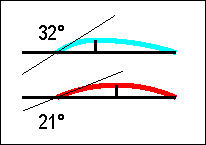|
There is some debate on the position of maximum draft needed in an IOM jib
and main. Some skippers insist that maximum draft should be about 45% of
chord, while others say 30%.

Draft position
I was interested to read what Frank Bethwaite had
to say on the position of maximum draft in his "Tasar" dinghy
class -- he was comparing maximum draft at 25% against 50% of chord:
"My authority for [my] statements are experiment and observation but
primarily model aircraft glide tests with different wing sections. The
dynamics of sailing to windward at max VMG in lighter wind are the same as the
dynamics of a glider which is looking for minimum sinking speed. A test model
with a wing with a thin section and max camber at 25% from the leading edge
was efficient at one particular speed. With a wing of identical shape and
weight but with max camber at 50% (ie. a circular arc section) it was as
efficient as the “knuckled” section [ie max draft at 25% of chord] at its
best point, but it maintained this efficiency over a wide speed range. In
smooth air the two sections could glide and lose height as well as each other.
In rough air the knuckled section became unstable and the model sank faster,
while the circular arc section continued to fly steadily in the rough air, the
model remained stable and sank more slowly."
This was interesting on two counts. One was that Graham
Bantock uses an aerofoil section on his rudder which he tells me is pretty much
the same as that used on competition (full size) gliders. Both model yacht
and full-size glider operate at similar Reynolds numbers.
The other was that Frank Bethwaite was clearly saying that draft
forward was not advised.
This is only half of the story, however. One of the key
things about draft amount and position is that they affect the entry angle --
and it is the entry angle which is so important while beating.

Entry angle depends upon draft amount and position
Will Gorgen sent me some comments on entry angle and its
importance:
However there is another principle that you need to keep track
of. That is the incidence angle at the leading edge. As you pull the
draft forward, you change the angle of the leading edge relative to the
incoming air flow. This causes your angle of incidence between the leading
edge and the incoming flow to decrease. In the extreme, this will cause
the front of the sail to luff and will effectively force you to sail lower
(foot) in order to keep your sail from luffing. When you sail lower, you
increase the overall angle of attack of the sail and move yourself closer to
stall.
Thus, moving your draft too far forward can cause your sail to
stall, and moving your draft too far back can cause your sail to stall. There
is an optimal draft position in between these two competing forces that will
determine your optimal draft position. This is often determined by your
individual sailing style. For people who like to point high, you generally
need the draft of the sail further back in order to keep the entry of the sail
at a positive angle of incidence and prevent the sail from luffing. For
people who like to foot, you can tolerate the draft further forward and sail
with a higher overall angle of attack and thus carry more force in the
sail. Of course optimal VMG depends on carefully balancing the lack of
windward progress with the extra speed that you get when you foot.
Moving your draft further forward allows you to generate more
drive in the sails and tolerate a higher angle of attack, but at the expense
of pointing.
The "Entry and exit angles"
page and associated spreadsheet explores these angles in more detail.
2005-12-18 | 